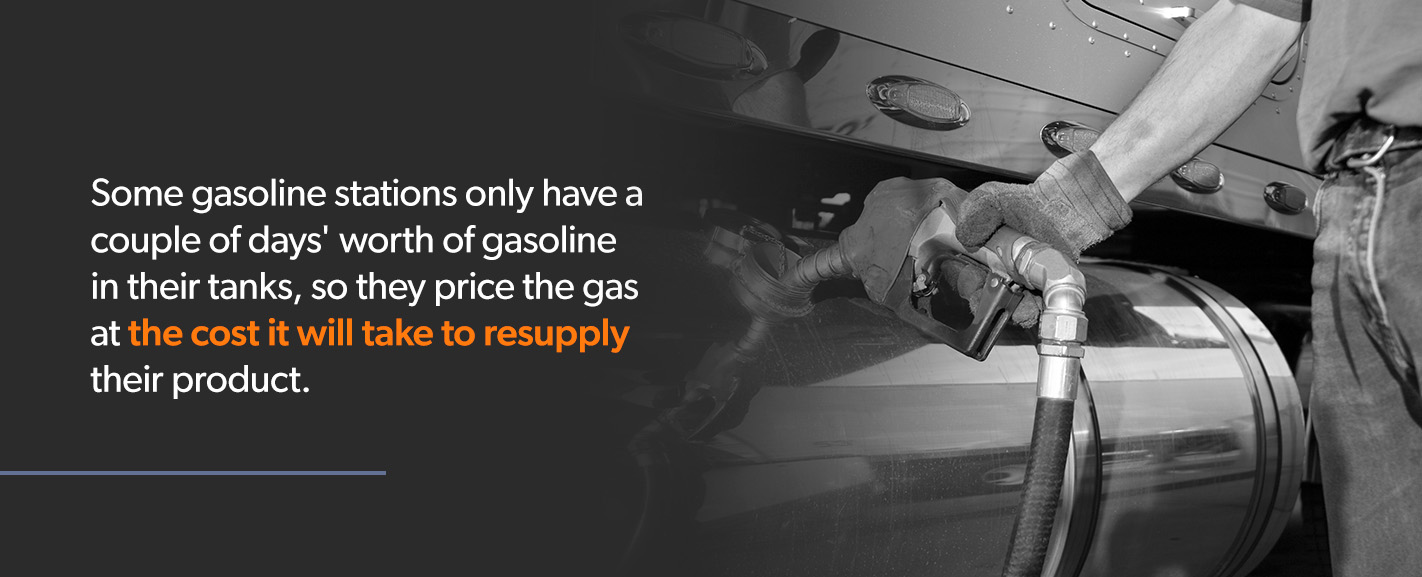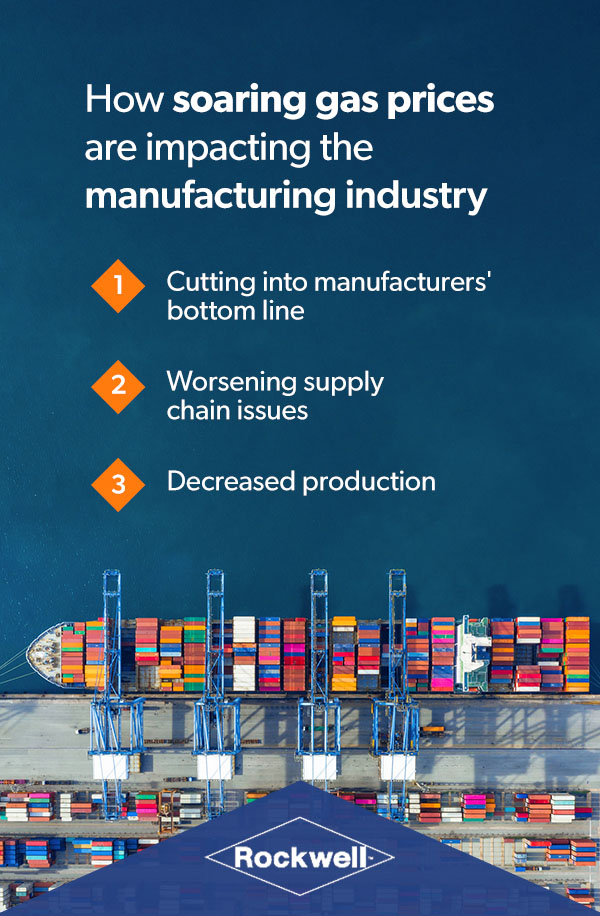With gas prices hitting record highs in recent months, companies and consumers alike are feeling the financial pinch at the pump. From steel producers to food processing companies, manufacturers across industries have to reduce or temporarily suspend production as energy costs soar. Rising oil prices also have a ripple effect on prices as it becomes more expensive to manufacture and ship products to their destinations.
How are gas prices impacting the manufacturing industry? Energy-intensive manufacturers are wondering what they can do about the cost of gas and how they can recover costs. In this guide to the current gas price situation, we’ll explain why prices have risen and what manufacturing companies can do to protect themselves.
It All Begins With Oil
To understand why gas prices are rising, we must first understand what affects the price of crude oil. Crude oil is the primary component of gasoline, so gas prices always reflect oil costs. For every $10 increase in the cost of crude oil, the cost of a gallon of gas rises by about $0.24. Refining, distribution and tax costs drive the remaining cost increase.
Several elements influence the price of oil and gas, combining to create an extremely volatile market.
1. Supply and Demand
The law of supply and demand is one of the most fundamental concepts of economics. When production decreases but demand remains the same, prices inevitably rise. With efforts from many countries worldwide to ban or reduce imports of Russian oil, supply is dwindling rapidly, forcing consumers to compete for a smaller quantity of gasoline.
While supply issues begin with production, supply at the pump also plays a role in cost. Some gasoline stations only have a couple of days’ worth of gasoline in their tanks, so they price the gas at the cost it will take to resupply their product. When oil is more expensive, it costs more to refill the tanks.
The demand from consumers usually increases in the spring and summer as more people travel. Since summer-grade gasoline is also more costly to produce, increased demand will hike prices even more as the weather warms.

2. The Dollar’s Value
When the value of the U.S. dollar decreases, oil and gas prices rise even more. A strong dollar allows the members of the Organization of Petroleum Exporting Countries to keep gas supply stable while continuing to make a profit. A weaker dollar motivates them to increase costs to make more money.
Special circumstances also play into the value of the dollar and changing gas prices at various times. Many economists believe the U.S. is currently dealing with inflation due to the federal government’s response to the Coronavirus pandemic. The residual effects of President Biden’s $1.9 trillion American Rescue Plan could be temporarily stoking rising inflation and weakening the dollar.
3. Commodities Traders
Commodities traders dealing in goods like gold, wheat and gasoline also drive the cost of oil and gas up or down. These traders buy oil on the commodities futures market, which allows traders to purchase gasoline for future delivery. However, most traders in these markets plan to sell the contract for a profit rather than assume ownership.
When commodities traders think gas prices will be high in the future, they often bid the contracts up higher. As prices rise, this creates an asset bubble. In this situation, gasoline prices soar higher than what the product is worth. While this will eventually lead to spending crashes, until that happens, consumers will have to pay the price when they fill the tank.
Manufacturing and Supply Chains
Many families across the U.S. are already driving less and cutting back on other expenses to lighten the pain at the pump. These costs affect manufacturers and the entire supply chain as well. Companies have to manage higher gas prices in many of the same ways consumers do, except on a larger scale.
Here’s how soaring gas prices are currently impacting the manufacturing industry.

1. Cutting Into Manufacturers’ Bottom Line
Many manufacturers worldwide rely on diesel fuel to power their supply chain and logistics. Semi-trucks, freight trains, airplanes and ships all use diesel to transport goods around the globe. When gas prices go up, shipping becomes significantly more expensive.
So how much does it cost to fill a semi-truck? According to the most recent data from the U.S. Energy Information Administration, the average cost of diesel fuel is about $0.50 more expensive than regular gasoline. Some freight truck drivers report paying between $600 and $900 to fuel up.
When it costs more to manufacture and ship products, companies must choose to either swallow the extra gas costs and lose money or increase prices to pass the costs down to the consumer. Most manufacturers have chosen to maintain their profits by increasing product prices.
Another side effect of higher gas prices is reduced consumer spending, cutting into manufacturers’ profits. As consumers must spend more of their paychecks on gasoline, they cut spending in other places, squeezing retailers and manufacturers already struggling with gas prices.
2. Worsening Supply Chain Issues
Gas prices are also disturbing the oil and gas supply chain, which has already affected the U.S. and other countries since the beginning of the Coronavirus pandemic. Once the pandemic and government lockdown measures took effect, Americans reduced their driving. Many people started working from home and stopped going out as often and the demand for gas fell.
In response, oil manufacturers slashed production. With the gradual recovery of the global economy and the effectiveness of vaccine rollouts, demand for gas has increased again. However, the global supply of gas and oil hasn’t yet returned to the same levels as pre-Coronavirus production. Experts predict it could take a while for supplies from U.S. oil producers to make their way to the consumer.
On top of this, the U.S. ban on Russian oil imports in March has also affected the oil and gas supply chain. Since a U.S. ban on Russian oil makes it more difficult for Russia to sell oil to other countries, the global market also takes a hit from these sanctions. Even though less than 10% of U.S. gas and oil supply comes from Russia, this domino effect causes U.S. gas prices to shoot up.
3. Decreased Production
While some manufacturers are struggling with increased shipping costs and distressed supply chains, others are curbing production to offset prices. Some industrial manufacturers have had to reduce or suspend production entirely in recent months because of energy costs.
President Biden’s emphasis on transitioning the U.S. away from fossil fuels may have also warned gas companies to proceed with caution when increasing production. This emphasis might make manufacturers uncertain about the future oil demand, further disrupting the global supply chain and placing manufacturers on unsteady ground.
What Can Manufacturers Do?
Many manufacturers are looking for solutions to the gas price crisis. While one of the best solutions would be for oil production companies to increase supplies, private companies, rather than the government, run gasoline production in the U.S. Manufacturers and private citizens have little influence or control over what oil production companies do.
Some industries and companies worldwide have lobbied for government intervention in rising prices, with varying success. For instance, a manufacturing trade group recently lobbied for the U.S. government to restrict oil and gas exports to help curb domestic price hikes. Other countries have implemented price caps to protect consumers, but even these caps are growing higher thanks to soaring prices.
Fortunately, there are a few things manufacturers can do now to lessen the sting of gas prices.
1. Maintain Company Vehicles
Keeping company vehicles in top shape is an essential part of fuel efficiency. Vehicles that function well can improve gas mileage and help your company make the most of each tank. Here are a few of the top ways you can maintain your company vehicles:
- Keep tires inflated: Properly inflated tires can improve fuel efficiency by 0.6% on average and up to 3% in certain situations. Tires lose pressure with continued use, and under-inflated tires can lower your gas mileage by around 0.2% for every 1 pound-force per square inch below the recommended tire pressure. Check the suggested tire pressure on the sticker on the driver’s side door.
- Tune-up the engine: Tuning up your vehicle’s engine can improve gas mileage by as much as 4%, though this varies on the type of work. The vehicle manual can provide more information about how frequently you should perform particular types of maintenance.
- Use the recommended motor oil grade: Using the manufacturer’s suggested oil grade can improve gas mileage by 1% to 2%. Vehicle manufacturers design their engines to use a certain kind of motor oil and matching your vehicle’s specifications can enhance its performance.
2. Reconsider Driving Habits
Some driving habits burn more fuel. Consider encouraging these changes to your company’s driving habits:
- Ease up on the pedals: Slow down and brake earlier. According to the U.S. Department of Energy, aggressive driving can lower a vehicle’s gas mileage between 15% and 30% at highway speeds. Easing up on the gas and brakes can save an average of $0.42 to $1.67.
- Avoid idling: Excessive idling with the air conditioner running can waste $0.02 to $0.04 a minute. When workers turn off the engine when parked, your company can save as much as half a gallon of gas per hour.
- Consider a company carpool: Some manufacturing companies may be able to start a commuting program for their employees. Carpooling can save employees money and minimize parking costs.
3. Find Alternatives to Gas

Fuel-efficient vehicle design has come a long way in recent years. If your manufacturing company is looking for solutions to increased gas prices, using electric vehicles could positively impact your bottom line. Many delivery and manufacturing companies are making the switch to electric trucks, a trend that’s likely to continue.
Although the electric vehicle market isn’t currently strong enough to replace gas-fueled cars, trucks and planes, you can still invest in more fuel-efficient vehicles. Consider the Environmental Protection Agency’s (EPA) rating of the next vehicle your company buys.
When Will Prices Go Down?
When can manufacturers expect gas prices to dip back down? With the national average currently just above $4 a gallon and some states paying higher than $5, there’s still a lot of volatility. Some experts predict that the average could continue rising until it reaches $5 across the country.
Many experts expect the issue to take a long time to resolve — a downward trend could take weeks, if not months. Some analysts believe gas prices will remain steady throughout April and even into the holiday months. The factors at play have been building for some time, and it will take a while to reverse the trend of rising gas prices.
The only way for gas prices to decrease faster than expected is for multiple circumstances to change at once. Here are a few factors that could drive the cost of gas back down.
1. Lowering Demand for Gas
Reducing demand for gasoline could also lower prices at the pump. However, this solution will only work if consumers and manufacturers cut driving or quickly switch to gasoline alternatives. Reduced demand could occur naturally if prices remain high, though this effect may take months.
2. Increasing Oil Supply
If demand remains the same, prices won’t drop unless a greater oil supply becomes available. Several places could provide the U.S. with additional oil:
- The strategic reserves: The U.S. could release additional oil barrels from its strategic reserves to contribute to the gas supply. As of March, the government committed to releasing 30 million barrels of oil. While this will certainly help with the immediate need for gasoline, it’s a temporary solution.
- Outside countries: The U.S. is in the process of seeking oil from external sources as well. If the government makes a deal with Venezuela and other countries to import more oil, they could provide a long-term solution to gas supplies.
- Russia: The tension between Russia and Ukraine has significantly impacted gas prices around the globe. If the conflict resolves, the U.S. government could remove sanctions, generating additional oil supply. However, even with an immediate resolution, it would still take a considerable time for this oil supply to reach American consumers.
- Private oil producers: Private oil companies could increase production to bring greater supplies to consumers. However, these manufacturers will want to ensure that they will turn a profit in doing so.
Contact Rockwell Security to Find Designs for Door Manufacturers
Gas prices rely on many complicated factors rather than any single policy. With issues like decreased oil supply, inflation and commodities traders driving up prices, manufacturers are searching for solutions to the drain at the pump. While your company can use several strategies to improve fuel efficiency, it may take a while for prices to return to normal and offer long-term relief.
Though gas prices can be uncertain, one constant you can count on is Rockwell Security’s custom door and window hardware. We provide purchasing agents and OEMs with elegant and secure hardware made with quality craftsmanship and durable materials that can stand the test of time. Our innovative designs are sure to enhance your unique designs.
Contact us today to find the solution to your door and window hardware needs.



Trackbacks & Pingbacks
[…] to satisfy immediate domestic demand. The most recent example was 2022, when the federal government released 30 million crude oil barrels from its strategic […]
[…] and braking slowly can also save you money. The U.S. Department of Energy says you can lower your gas mileage by 15%-30% on the highway when you drive aggressively. You can save $0.42 to $1.67 on gas when you ease up on […]
[…] braking slowly can even prevent cash. The U.S. Department of Energy says you’ll be able to lower your gas mileage by 15%-30% on the freeway while you drive aggressively. You can save $0.42 to $1.67 on gasoline while you ease […]
[…] and braking slowly can also save you money. The U.S. Department of Energy says you can lower your gas mileage by 15%-30% on the highway when you drive aggressively. You can save $0.42 to $1.67 on gas when you ease up on […]
[…] to satisfy immediate domestic demand. The most recent example was 2022, when the federal government released 30 million crude oil barrels from its strategic […]
Comments are closed.